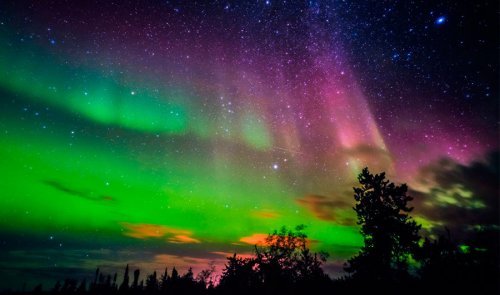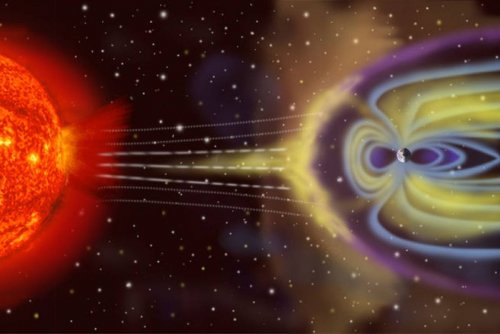Ion currents and natural magnetic phenomena
If charged particles move in a gas in the presence of an external magnetic field, they are free to describe a significant part of their magnetron trajectory. However, each trajectory does not necessarily complete completely. It can be broken by a collision between a moving particle and any gas molecule.
Such collisions sometimes only deflect the particles' direction of motion, transferring them to new trajectories; however, with sufficiently strong collisions, ionization of gas molecules is also possible. In the post-collision period leading to ionization, it is necessary to take into account the existence of three charged particles—the original moving particle, the gas ion, and the liberated electron. The motions of the ionizing particle before the collision, the gas ion, the released electron, and the ionizing particle after the collision are affected by Lorentz forces.
The interaction of ionizing and ionized particles with a magnetic field as these particles move in a gas gives rise to various natural magnetic phenomena—aurora, singing flame, solar wind, and magnetic storms.
Polar lights
The northern lights are the glow in the sky that is sometimes seen. region of the Earth's north pole. This phenomenon occurs as a result of the deionization of atmospheric molecules after they are ionized by solar radiation. A similar phenomenon in the southern hemisphere of the Earth is called the southern lights. The sun emits large amounts of energy in many different forms. One of these forms is charged fast particles of various types, radiating in all directions. Particles moving towards the Earth fall into the geomagnetic field.
All charged particles from extraterrestrial space that fall into the geomagnetic field, regardless of the initial direction of movement, move to trajectories corresponding to the field lines. Since all these lines of force exit from one pole of the Earth and enter the opposite pole, the moving charged particles end up at one or the other pole of the Earth.
The rapidly charged particles entering the Earth's atmosphere near the poles encounter atmospheric molecules. Collisions between particles of solar radiation and gas molecules can lead to ionization of the latter, and electrons are knocked out of some molecules. Due to the fact that ionized molecules have more energy than deionized ones, electrons and gas ions tend to recombine. In cases where ions are reunited with previously lost electrons, electromagnetic energy is emitted. The term "aurora" is used to describe the visible part of this electromagnetic radiation.
The presence of a geomagnetic field is one of the favorable factors for all forms of life, because this field serves as a "roof" that protects the central part of the globe from continuous bombardment by fast particles of solar origin.
Singing flame
A flame placed in an alternating magnetic field can generate sounds at the frequency of the magnetic field. A flame consists of high-temperature gaseous products formed during certain chemical reactions. When, under the influence of high temperature, the orbital electrons are separated from some gas molecules, a rich mixture of free electrons and positive ions is created.
In this way, the flame generates both electrons and positive ions, which can serve as carriers to maintain the electric current. At the same time, the flame creates temperature gradients that cause convective flows of gases that form the flame. Since electric charge carriers are an integral part of gases, convection flows are also electric currents.
These convection electric currents existing in the flame, in the presence of an external magnetic field, are subject to the action of Lorentz forces. Depending on the nature of the interaction between the current and the field, the application of an external magnetic field can either decrease or increase the brightness of the flame.
The pressure of the gases in the flame interacting with an alternating magnetic field is modulated by the Lorentz forces acting on the convection flows. Since sound vibrations are generated as a result of gas pressure modulation, the flame can serve as a transducer that converts electrical energy into sound.A flame that has the properties described is called a singing flame.
Magnetosphere
The magnetosphere is the region of the Earth's environment where the magnetic field plays a dominant role. This field is the vector sum of the Earth's own magnetic field, or geomagnetic field, and the magnetic fields associated with solar radiation. As a superheated body undergoing strong thermal and radioactive disturbances, the Sun ejects vast quantities of plasma consisting of approximately half electrons and half protons.
Although plasma is ejected from the surface of the Sun in all directions, a significant part of it, moving away from the Sun, forms a trail directed more or less in one direction under the influence of the movement of the Sun in space. This migration of plasma is called the solar wind.
As long as the electrons and protons that make up the solar wind move together, having equal concentrations, they do not create a magnetic field. However, any differences in their drift velocity generate an electric current, and differences in concentration generate a voltage capable of producing an electric current. In each case, the plasma currents generate corresponding magnetic fields.
Earth is in the path of the solar wind. When its particles and their associated magnetic field approach the Earth, they interact with the geomagnetic field. As a result of the interaction, both fields change. Thus, the shape and characteristics of the geomagnetic field are determined in part by the solar wind passing through it.
The radiative activity of the Sun is extremely variable both in time and in space — across the surface of the Sun.When the sun rotates on its axis, the solar wind is in a state of flux. Due to the fact that the Earth also rotates on its axis, the nature of the interaction between the solar wind and the geomagnetic field is also constantly changing.
Essential manifestations of these changing interactions are called magnetospheric storms in the solar wind and magnetic storms in the geomagnetic field. Other phenomena related to interactions between solar wind particles and the magnetosphere are the auroras mentioned above and the electric current flowing in the atmosphere around the Earth from east to west.


